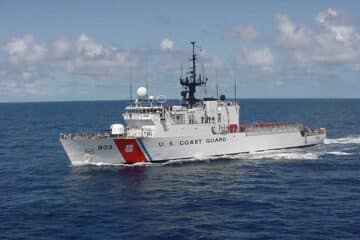“Getting a Polar Security Cutter fielded is an absolute top priority for the organization,” said Admiral Linda Fagan. “We’re on budget, we’re on contract …. I look forward to seeing that ship beginning to be constructed and then eventually fielded and in full operation.”
Welding work is commencing on three build units purchased for the first ship.
Delivered as a joint programme between the USCG and the US Navy, the Polar Security Cutter programme consists of potentially three ships; work on the first two is underway at Bollinger Shipyard, Mississippi.
“I’m focused on fielding the Polar Security Cutters …. [and] getting that first one well into construction, with some predictability around when that ship will come to full operating capacity. We’re working hard with the yard, with the navy, and with the programme office to bring some better certainty and clarity around that,” said Adm Fagan.
The Polar Security Cutters are designed to provide heavy ice-breaking capability. “As a country, we need that ice-breaking capacity now,” said Adm Fagan.
“This has been a long-standing conversation: how many ice breakers does the United States need as an Arctic country? We’ve been consistent for several years: we need a heavy ice breaker now, and at least three of those heavy ice breakers.”
Admiral Linda Fagan, Chief of the U.S. Coast Guard
“We’re 100% committed to getting that first Polar Security Cutter built and fielded, and I’m 100% confident in the design,” the admiral continued. “The imperative is here, now.”
“For an Arctic country, our polar interest – both in the Arctic and Antarctic – are front and centre, [so] we’re leaned into that work,” said Adm Fagan. The Commandant noted that, despite the climate change-driven reduction in Arctic ice, for example, “In our lifetimes, we will not see an Arctic where we don’t need ice-breaking capacity.” “For an Arctic country, we need to be leaned into creating on-scene presence capacity for year-round access,” she continued. “Having persistent presence year-round in the high latitudes is critical to our national security and national sovereignty.”

Adm Fagan said the Polar Security Cutters are complex to build, consisting of at least 85 different units.
Their increasing design and build complexity reflects wider trends in the USCG’s new capability programme. Here, Rear Admiral Chad Jacoby – USCG Assistant Commandant for Acquisition/Chief Acquisition Officer – told the symposium, there is “Huge focus on replacing 40- or 50-year old ships with new assets. In all cases, the new assets are larger, and many times the complexity of the ships we’re replacing.”
The Polar Security Cutter design is complex in conceptual terms, too. This is evident in the ship’s type name being a polar security cutter, rather than a heavy ice-breaker, Rear Adm Jacoby explained.
“The distinction there is the Polar Security Cutter is going to do way more than break ice. It will have National Security Cutter-level capabilities, sensors, and equipment on a hull that can go anywhere in the world in any season,” Rear Adm Jacoby continued. “So, we’re not just breaking ice, we’re not just having presence: we’re going to be able to execute almost all USCG missions up in the Arctic, down in the Antarctic, anywhere in the world.”






